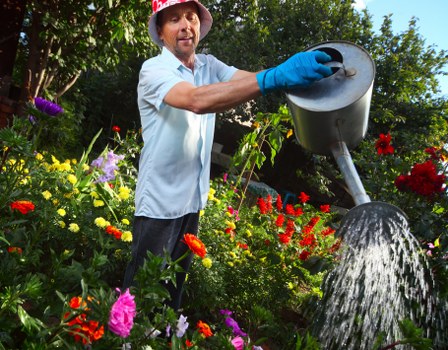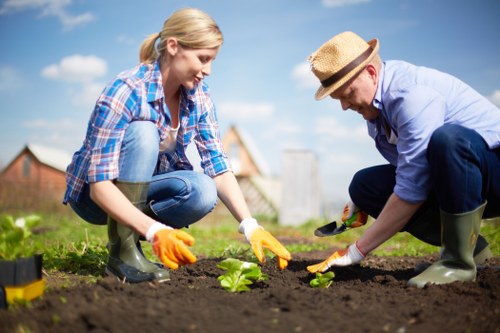Transforming Urban Spaces: Landscaping in Docklands

Docklands, an area renowned for its vibrant mix of commercial, residential, and recreational spaces, presents unique challenges and opportunities for landscaping. As urban development continues to surge, the integration of green spaces becomes increasingly vital for enhancing the aesthetic appeal, environmental sustainability, and livability of this bustling district.
Effective landscaping in Docklands requires a thoughtful approach that harmonizes with the area's contemporary architecture and waterfront views. It involves selecting appropriate plant species, designing functional outdoor spaces, and incorporating sustainable practices to create a balanced urban ecosystem.
Moreover, landscaping serves as a vital component in fostering community engagement and providing residents and visitors with serene retreats amidst the urban hustle. Whether it's creating lush gardens, installing innovative water features, or designing pedestrian-friendly pathways, thoughtful landscaping can significantly elevate the Docklands experience.
The Importance of Landscaping in Urban Docklands

Landscaping in Docklands is not just about adding greenery; it's about creating a sustainable and appealing environment that supports both the ecosystem and the community. Here are some key reasons why landscaping is essential in this urban area:
- Environmental Benefits: Green spaces help in reducing urban heat islands, improving air quality, and managing stormwater runoff.
- Aesthetic Appeal: Well-designed landscapes enhance the visual appeal of buildings and public areas, making Docklands more attractive to residents and tourists.
- Community Well-being: Accessible parks and gardens provide spaces for recreation, relaxation, and social interactions, contributing to the overall well-being of the community.
- Economic Value: Quality landscaping can increase property values and attract businesses, boosting the local economy.
By prioritizing landscaping, Docklands can achieve a harmonious balance between urban development and natural beauty, ensuring a high quality of life for its inhabitants.
Design Principles for Effective Landscaping in Docklands

To achieve impactful landscaping in Docklands, it's essential to adhere to core design principles that address the unique characteristics of the area. These principles include:
- Site Analysis: Understanding the specific conditions of the Docklands site, including soil type, climate, sunlight exposure, and existing vegetation, to inform design decisions.
- Sustainable Practices: Incorporating eco-friendly materials, water-efficient irrigation systems, and native plant species to promote sustainability.
- Functional Design: Creating spaces that serve multiple purposes, such as combining aesthetic beauty with recreational functionality.
- Accessibility: Ensuring that landscaped areas are accessible to all, including individuals with disabilities.
- Integration with Surroundings: Designing landscapes that complement the architectural styles and urban infrastructure of Docklands.
By following these design principles, landscaping projects in Docklands can create environments that are both beautiful and practical.
Choosing the Right Plant Species

Selecting appropriate plant species is crucial for the success of landscaping in Docklands. Factors to consider include:
- Climate Suitability: Plants must be able to thrive in the local climate conditions, including temperature ranges and precipitation levels.
- Maintenance Requirements: Choosing low-maintenance plants can reduce upkeep costs and efforts.
- Native versus Non-Native: Native plants often require less water and are better adapted to the local ecosystem, promoting biodiversity.
- Aesthetic Appeal: Selecting plants that provide year-round interest through foliage, flowers, and structural elements.
By carefully selecting plant species, landscapers can ensure that Docklands' green spaces remain vibrant and resilient throughout the seasons.
Incorporating Sustainable Practices

Sustainability is a key consideration in modern landscaping, especially in urban areas like Docklands. Sustainable landscaping practices include:
- Water Conservation: Implementing drip irrigation systems, rainwater harvesting, and drought-resistant plants to minimize water usage.
- Soil Health: Using compost and other organic materials to improve soil fertility and structure.
- Energy Efficiency: Planting trees strategically to provide shade and reduce the need for artificial cooling.
- Waste Reduction: Utilizing recycled materials for pathways, furniture, and other landscape features.
- Biodiversity Enhancement: Creating habitats for local wildlife through diverse plantings and the inclusion of features like birdhouses and water sources.
Adopting these sustainable practices helps in creating a resilient and eco-friendly landscape that benefits both the environment and the community.
Popular Landscaping Features in Docklands

Docklands offers a variety of landscaping features that cater to diverse tastes and functional needs. Some of the most popular features include:
- Waterfront Gardens: These gardens leverage the scenic waterfront views, incorporating water elements like ponds, fountains, and streams to enhance the tranquil ambiance.
- Rooftop Gardens: Utilizing rooftop spaces for greenery helps in maximizing urban space and provides additional recreational areas.
- Public Parks: Expansive parks with walking trails, playgrounds, and picnic areas serve as community hubs for leisure and social activities.
- Vertical Gardens: Ideal for limited spaces, vertical gardens add greenery to building facades and create visually striking landscapes.
- Green Roofs: These roofs are covered with vegetation, providing insulation, reducing stormwater runoff, and enhancing building aesthetics.
These landscaping features not only beautify Docklands but also contribute to environmental sustainability and community well-being.
Lighting and Outdoor Amenities

Integrating lighting and outdoor amenities into Docklands' landscapes enhances their functionality and safety. Key elements include:
- Pathway Lighting: Ensures safe navigation through landscaped areas during nighttime hours.
- Accent Lighting: Highlights specific landscape features, such as trees, sculptures, and water installations.
- Seating Areas: Providing comfortable seating encourages visitors to spend more time in green spaces.
- Recreational Facilities: Including elements like benches, gazebos, and fitness stations caters to various recreational needs.
- Public Art Installations: Incorporating art pieces can add cultural value and visual interest to landscapes.
These amenities not only enhance the user experience but also ensure that landscaped areas remain vibrant and active beyond daylight hours.
Maintenance Strategies for Docklands Landscapes

Proper maintenance is essential for preserving the beauty and functionality of Docklands' landscapes. Effective maintenance strategies include:
- Regular Pruning and Trimming: Keeps plants healthy and shapes them aesthetically.
- Weed Control: Prevents unwanted plants from overtaking landscaped areas.
- Irrigation Management: Ensures that plants receive adequate water without wastage.
- Soil Testing and Fertilization: Maintains soil health and provides necessary nutrients for plant growth.
- Pest and Disease Management: Identifies and treats issues promptly to protect plant health.
Implementing these maintenance practices ensures that Docklands' landscapes remain lush, vibrant, and inviting throughout the year.
Seasonal Considerations

Landscaping in Docklands must account for seasonal variations to maintain year-round appeal. Key considerations include:
- Spring: Focus on planting seasonal blooms and rejuvenating green spaces after winter.
- Summer: Implement shading strategies and water-efficient practices to cope with heat.
- Autumn: Manage fallen leaves and prepare plants for colder weather.
- Winter: Protect plants from frost and consider evergreen species to maintain greenery.
Adapting landscaping practices to each season ensures sustained beauty and functionality in Docklands' outdoor spaces.
Innovative Landscaping Solutions for Docklands

Embracing innovation in landscaping can set Docklands apart as a forward-thinking urban area. Some cutting-edge solutions include:
- Smart Irrigation Systems: Utilizing technology to optimize water usage and reduce waste.
- Green Walls: Creating living walls that purify air and add vertical greenery to buildings.
- Permeable Pavements: Allowing water to seep through surfaces, reducing runoff and promoting groundwater recharge.
- Solar-Powered Lighting: Integrating renewable energy sources into outdoor lighting solutions.
- Modular Landscaping: Using adaptable modules that can be reconfigured to meet changing needs.
These innovative approaches not only enhance the aesthetic and functional aspects of Docklands' landscapes but also contribute to sustainability and resilience.
Community Engagement in Landscaping Projects

Involving the community in landscaping projects fosters a sense of ownership and ensures that the spaces meet the needs of those who use them. Strategies for community engagement include:
- Public Consultations: Gathering input from residents and stakeholders during the planning phases.
- Volunteer Programs: Encouraging community members to participate in planting and maintenance activities.
- Educational Workshops: Providing information on sustainable gardening and landscaping practices.
- Collaborative Design: Working with local artists and designers to create culturally relevant landscape features.
By actively engaging the community, landscaping projects in Docklands can become a collective effort that reflects the values and preferences of its diverse population.
Case Studies: Successful Landscaping in Docklands

Examining successful landscaping projects in Docklands provides valuable insights into effective practices and innovative designs. Here are a few notable examples:
- Waterfront Park Revitalization: This project transformed an underutilized waterfront area into a vibrant park featuring walking trails, interactive water features, and native plant gardens.
- Vertical Garden Installation: A major office building incorporated vertical gardens on its facade, enhancing its aesthetic appeal and improving air quality for occupants.
- Rooftop Green Spaces: Several residential complexes in Docklands introduced rooftop gardens equipped with seating areas, greenery, and solar-powered lighting, providing residents with serene outdoor spaces.
- Permeable Pavement Pathways: City planners installed permeable pavements in public walkways, effectively managing stormwater runoff and reducing environmental impact.
These case studies demonstrate the transformative power of thoughtful landscaping in urban settings, highlighting the benefits of green spaces in enhancing livability and sustainability.
Lessons Learned from Docklands Projects

Key takeaways from successful landscaping projects in Docklands include:
- Integrated Planning: Coordinating landscaping efforts with urban development plans ensures cohesive and functional spaces.
- Stakeholder Collaboration: Engaging multiple stakeholders, including government entities, businesses, and the community, fosters collaborative solutions.
- Adaptability: Designing flexible landscapes that can adapt to changing needs and environmental conditions is crucial for long-term success.
- Focus on Sustainability: Prioritizing sustainable practices ensures that landscaping efforts contribute positively to the environment.
- Innovative Design: Embracing creativity and new technologies can lead to unique and impactful landscape features.
These lessons can guide future landscaping initiatives in Docklands, promoting practices that are both effective and sustainable.
Selecting the Right Landscaping Contractor in Docklands

Choosing a reputable landscaping contractor is essential for the successful execution of landscaping projects in Docklands. Consider the following factors when selecting a contractor:
- Experience: Look for contractors with a proven track record in urban landscaping, particularly in similar environments to Docklands.
- Portfolio: Review the contractor's previous work to assess their design capabilities and quality of execution.
- Services Offered: Ensure that the contractor provides comprehensive services, including design, installation, and maintenance.
- Client Reviews: Consider feedback from past clients to gauge the contractor's reliability and professionalism.
- Sustainability Practices: Choose contractors who prioritize eco-friendly practices and sustainable materials.
- Licensing and Insurance: Verify that the contractor holds the necessary licenses and insurance to operate in Docklands.
By carefully selecting a landscaping contractor, you can ensure that your Docklands project is executed to the highest standards, resulting in a beautiful and sustainable landscape.
Questions to Ask Potential Contractors

When interviewing potential landscaping contractors, consider asking the following questions:
- Can you provide examples of similar projects you have completed in Docklands?
- What is your approach to sustainable landscaping?
- How do you handle project timelines and potential delays?
- What guarantees or warranties do you offer for your work?
- How do you manage maintenance and upkeep post-installation?
- Can you provide references from past clients?
These questions can help you assess the contractor's expertise, reliability, and compatibility with your project needs.
Cost Considerations for Landscaping in Docklands

Budgeting for landscaping in Docklands involves several factors that can influence the overall cost. Understanding these elements can help in planning and managing expenses effectively:
- Design Complexity: Intricate designs with unique features typically require more time and resources, increasing costs.
- Material Selection: The choice of materials, such as premium plants, sustainable materials, and specialized equipment, can impact the budget.
- Size of the Area: Larger landscapes require more materials and labor, leading to higher costs.
- Labor Costs: Skilled labor, especially for specialized tasks like installing green walls or rooftop gardens, can affect overall expenses.
- Maintenance Requirements: Ongoing maintenance services add to the long-term costs of landscaping projects.
By carefully considering these factors, property owners and developers can create a realistic budget that accommodates their landscaping aspirations in Docklands.
Budgeting Tips for Landscaping Projects

To manage landscaping costs effectively in Docklands, consider the following budgeting tips:
- Set Clear Goals: Define the objectives and priorities of your landscaping project to allocate funds efficiently.
- Plan for Contingencies: Allocate a portion of your budget for unexpected expenses or changes in the project scope.
- Choose Cost-Effective Materials: Select materials that offer a balance between quality and affordability without compromising on aesthetics.
- Phased Implementation: Implement the project in stages to spread out costs over time.
- Seek Multiple Quotes: Obtain estimates from several contractors to ensure competitive pricing.
These budgeting strategies can help in achieving a successful landscaping project in Docklands without exceeding financial constraints.
Future Trends in Docklands Landscaping

The field of landscaping is continuously evolving, with new trends emerging that reflect changing societal values and technological advancements. Future trends likely to influence Docklands landscaping include:
- Biophilic Design: Integrating natural elements into urban environments to enhance human well-being.
- Smart Landscaping: Utilizing technology for automated irrigation, lighting, and maintenance.
- Edible Landscapes: Incorporating food-producing plants into public and private gardens.
- Resilient Landscapes: Designing landscapes that can withstand extreme weather events and adapt to climate change.
- Interactive Public Spaces: Creating landscapes that encourage user interaction through dynamic installations and flexible spaces.
Staying abreast of these trends can help Docklands maintain its reputation as a modern and sustainable urban area.
Embracing Technology in Landscaping

Technology plays a significant role in advancing landscaping practices in Docklands. Key technological integrations include:
- Drones: Used for mapping and planning large landscapes, providing aerial views and data analysis.
- 3D Modeling Software: Assists in visualizing designs and making adjustments before implementation.
- Automated Irrigation Systems: Ensure precise water delivery based on real-time weather and soil data.
- LED Lighting: Energy-efficient lighting solutions that enhance landscape features.
- Robotic Maintenance: Robots for tasks like mowing and pruning, increasing efficiency and reducing labor costs.
Integrating these technologies can enhance the efficiency, sustainability, and aesthetic quality of landscaping projects in Docklands.
Conclusion: Enhancing Docklands Through Thoughtful Landscaping

Landscaping in Docklands is a multifaceted endeavor that combines aesthetic beauty, environmental sustainability, and community well-being. By embracing thoughtful design principles, sustainable practices, and innovative solutions, Docklands can continue to thrive as a vibrant and livable urban area.
Investing in quality landscaping not only enhances the visual appeal of Docklands but also contributes to a healthier, more sustainable environment. It fosters a sense of community, provides recreational opportunities, and adds economic value to the area.
Whether you are a property owner, developer, or resident, prioritizing landscaping in Docklands can lead to a more harmonious and enjoyable urban experience. Contact us today to explore how we can help transform your space with exceptional landscaping services tailored to the unique needs of Docklands.
Ready to Transform Your Docklands Space?
Discover the difference professional landscaping can make. Book your service now and create a stunning outdoor environment that complements the dynamic essence of Docklands.